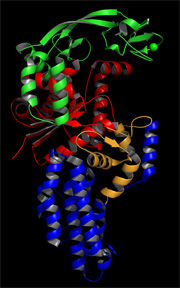
Rebecca W. Alexander
Department of Chemistry
Wake Forest University
Publications
Peer-reviewed:
13) Budiman, M.E., Knaggs, M.H., Fetrow, J.S., and Alexander, R.W. "Using molecular dynamics simulations to probe interaction networks in an aminoacyl-tRNA synthetase." Proteins 2007, 68: 670-689.
12) Turner, A.W., Love, C., Alexander, R.W., and Jones, P.G. "Mutational analysis of E. coli DEAD-box protein CsdA." J. Bacteriology 2007, 189: 2769-2776.
11) Budiman, M.E., Bierbach, U., and Alexander, R.W. “DNA minor groove adducts formed by a platinum-acridine conjugate inhibit association of TATA-binding protein with its cognate sequence.” Biochemistry 2005, 44: 11262-11268.10) Budiman, M.E., Alexander, R.W., and Bierbach, U. “Unique base-step recognition by a platinum-acridinylthiourea conjugate leads to a DNA damage profile complementary to that of the anticancer drug cisplatin.” Biochemistry 2004, 43: 8560-8567.
9) Alexander, R.W., and Tamura, K. “Peptide synthesis through evolution.” Cell. Mol. Life Sci. 2004, 61: 1317-1330.
8) Alexander, R.W., and Schimmel, P. “Domain-domain communication in aminoacyl-tRNA synthetases.” Prog. Nucl. Acid Res. Mol. Biol. 2001, 69: 317-349.
7) Alexander, R.W., and Schimmel, P. “Evidence for breaking domain-domain functional communication in a synthetase-tRNA complex.” Biochemistry 1999, 38: 16359-16365.
6) Wang, R., Alexander, R.W., van Loock, M., Vladimirov, S., Bukhtiyarov, Y., Harvey, S.C., and Cooperman, B.S. “Three-dimensional placement of the conserved 530 loop of 16 S rRNA and of its neighboring components in the 30 S subunit.” J. Mol. Biol. 1999 , 286: 521-540.
5) Alexander, R.W., Nordin, B.E., and Schimmel, P. “Activation of microhelix charging by localized helix destabilization.” Proc. Natl. Acad. Sci. USA 1998, 95: 12214-12219.
4) Alexander, R.W., and Cooperman, B.S. “Ribosomal proteins neighboring 23 S rRNA nucleotides 803-811 within the 50 S subunit.” Biochemistry 1998 , 37: 1714-1721.
3) Muralikrishna, P., Alexander, R.W., and Cooperman, B.S. (1997) “Placement of the a- sarcin loop within the 50 S subunit: Evidence derived using a photolabile oligodeoxynucleotide probe.” Nucleic Acids Res. 1997 , 25: 4562-4569.
2) Alexander, R.W., Muralikrishna, P., and Cooperman, B.S. “Ribosomal components neighboring the conserved 518-533 loop of 16S rRNA in 30S subunits.” Biochemistry 1994, 33: 12109-12118.
1) Rosen, K.V., Alexander, R.W., Wower, J., and Zimmermann, R.A. “Mapping the central fold of transfer RNA 2 fMet in the P-site of the Escherichia coli ribosome.” Biochemistry 1993, 32: 12802-12811.
Invited contributions:
12) Alexander, R.W. “Measure for measure: a zinc finger ruler.” Trends Biochem. Sci. 2002 , 27: 390.
11) Alexander, R.W. “Not so picky: a permissive thioesterase domain cyclizes novel integrin binders.” Trends Biochem. Sci. 2002 , 27: 119-120.
10) Alexander, R.W., and Schimmel, P. “Protein synthesis” In Encyclopedia of Physical Science and Technology (Robert A. Myers, ed.) 3 rd ed., Vol. 13. 2002, Academic Press ( San Diego, CA), 219-240.
9) Alexander, R.W., and Schimmel, P. “Suppression” In Encyclopedia of Genetics (S. Brenner and J. Miller, Eds), 2001, Academic Press, London, 1897-1899.
8) Alexander, R.W., and Schimmel, P. “Wobble hypothesis” In Encyclopedia of Genetics (S. Brenner and J. Miller, Eds.), 2001, Academic Press, London, 2140-2141.
7) Alexander, R.W. “Choking on a knot: insecticidal properties of cyclotides.” Trends Biochem. Sci. 2001 , 26: 588.
6) Alexander, R.W. “Peptides with zip: small molecules for structure prediction.” Trends Biochem. Sci. 2001 , 26: 352.
5) Alexander, R.W. “Teasing apart the Taxol pathway.” Trends Biochem. Sci. 2000 , 26: 152.
4) Cooperman, B.S., Alexander, R.W., Bukhtiyarov, Y., Vladimirov, S.N., Druzina, Z., Wang, R., and Zuno, N. “Photolabile derivatives of oligonucleotides as probes of ribosomal structure.” Methods Enzymol. 2000, 318: 118-136.
3) Alexander, R.W., and Schimmel, P. “Multifunctional proteins.” In McGraw-Hill 2001 Yearbook of Science & Technology, McGraw-Hill, New York, pp. 265-266.
2) Alexander, R.W. “Reducing (oxidative) stress: structure and mechanism.” Trends Biochem. Sci. 2000, 25: 643.
1) Alexander, R.W. “A chiral attraction.” Trends Biochem. Sci. 2000, 25: 427.
Rebecca W. Alexander
Department of Chemistry
Wake Forest University
Winston-Salem, NC 27109
alexanr@wfu.edu
336-758-5568 (phone)
336-758-4656 (fax)